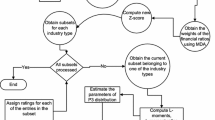Abstract
Information value is widely used to assess discriminatory power of credit scoring models, i.e. models that try to predict a probability of client’s default. Moreover it is very often used to assess the discriminatory power of variables that enter into these models. This means that the Information value is used as a filter for variable selection. However, empirical estimate using deciles of scores, which is the common way how to compute it, may lead to strongly biased results. The main aim of this paper is to give an alternative estimator of the information value, named ESIS2, which leads to lowered bias and mean square error. The implication of this is better credit scoring model. And what is essential, the direct consequence of having better credit scoring model is significantly higher profitability of credit business.











Similar content being viewed by others
References
Anderson, R. (2007). The credit scoring toolkit: Theory and practice for retail credit risk management and decision automation. Oxford: Oxford University Press.
Crook, J. N., Edelman, D. B., & Thomas, L. C. (2007). Recent developments in consumer credit risk assessment. European Journal of Operational Research, 183(3), 1447–1465.
Desai, V. S., Crook, J. N., & Overstreet, G. A, Jr. (1996). A comparison of neural networks and linear scoring models in the credit union environment. European Journal of Operational Research, 95(1), 24–37.
Hand, D. J., & Henley, W. E. (1997). Statistical classification methods in consumer credit scoring: A review. Journal of the Royal Statistical Society, Series A., 160(3), 523–541.
Johnson, N. L., Kotz, S., & Balakrishnan, N. (1994). Continuous univariate distributions (2nd ed., Vol. 1). New York: Wiley.
Koláček, J., & Řezáč, M. (2010). Assessment of scoring models using information value. In Proceedings of Compstat’ 2010 (pp. 1191–1198). Paris.
Kundu, D., & Manglick, A. (2005). Discriminating between the log-normal and gamma distributions. Journal of the Applied Statistical Sciences, 14, 175–187.
Hsieh, Nan-Chen. (2005). Hybrid mining approach in the design of credit scoring models. Expert Systems with Applications, 28(4), 655–665.
Hsieh, Nan-Chen, & Hung, Lun-Ping. (2010). A data driven ensemble classifier for credit scoring analysis. Expert Systems with Applications, 37(1), 534–545.
Řezáč, M. (2011). Measuring quality of scoring models using information value. Journal of Communication and Computer, 8(3), 234–239.
Řezáč, M. & Koláček, J. (2011). Computation of information value for credit scoring models. In Workshop of the Jaroslav Hájek Center and Financial Mathematics in Practice I. Book of short papers. Jedovnice pp. 75–84.
Řezáč, M., & Řezáč, F. (2011). How to measure the quality of credit scoring models. Finance a úvěr: Czech Journal of Economics and Finance, 61(5), 486–507.
Siddiqi, N. (2006). Credit risk scorecards: developing and implementing intelligent credit scoring. Hoboken, NJ: Wiley.
Thomas, L. C. (2009). Consumer credit models: pricing, profit, and portfolio. Oxford: Oxford University Press.
Thomas, L. C., Edelman, D. B., & Crook, J. N. (2002). Credit scoring and its applications. Philadelphia, PA: SIAM Monographs on Mathematical Modeling and Computation.
Wiens, B. L. (1999). When log-normal and gamma models give different results: A case study. The American Statistician, 53(2), 89–93.
Wilkie, A. D. (2004). Measures for comparing scoring systems. In L. C. Thomas, D. B. Edelman, & J. N. Crook (Eds.), Readings in credit scoring (pp. 51–62). Oxford: Oxford University Press.
Author information
Authors and Affiliations
Corresponding author
Rights and permissions
About this article
Cite this article
Řezáč, M. ESIS2: Information Value Estimator for Credit Scoring Models. Comput Econ 45, 303–322 (2015). https://doi.org/10.1007/s10614-014-9424-0
Accepted:
Published:
Issue Date:
DOI: https://doi.org/10.1007/s10614-014-9424-0




